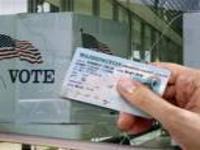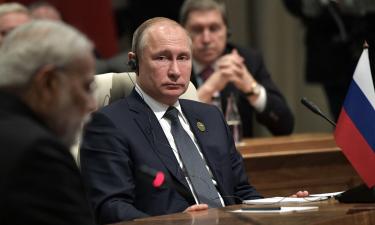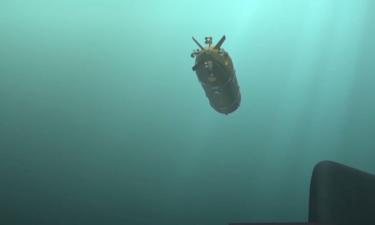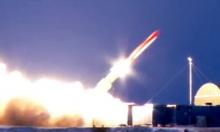US Elections explained
How does the electoral process start?

Technically speaking, any person who is a natural born US citizen at least 35 years of age and who has resided in the US for at least 14 years may run and be elected President. However, running for President in the US requires enormous financial resources. Once someone decides to run for President, they have to garner a certain number of votes to get their name on the ballot in each state. This is a near impossible task for anyone not belonging to the two major parties. Television and radio ads, travel, participation in debates all necessitate that one has the backing and support of one of the two parties. Today, states usually require from 250 to 25,000 signatures to get on the ballot.
For established party members, a formal announcement is made of their candidacy. Backing by one of the two major parties guarantees a lion’s share of campaign funding, national recognition and assistance of party apparatus in the process of obtaining support and getting on the ballot. Individuals, political action committees of corporations, labor unions and other interests and organizations contribute to candidate campaigns. After nine months of fundraising, the candidates for president in 2008 have already raised about $420 million. This presidential money pursuit seems to be on track to collect an unprecedented $1 billion total. By some predictions, the nominees will need to raise $500 million apiece to compete--a record sum.
Legislators tried in the 1970s to reverse the growing importance of money by providing a limited system of public financing for the general election by offering matching funds from the federal government for candidates who agree to cap their spending at a specified level. Top candidates have begun opting out of that system, however, reasoning that they can raise far more than the government offers.
So we can conclude the presidency and ultimately the government are controlled by corporate elitists?
Yes both the presidency and ultimately the government are controlled by corporate elitists. Wealthy individuals and corporations have full control of the US media and press and US elected representatives in public office who set policy. They are the ones who finance the massively expensive campaigns of candidates running for office.
And as regards the electorate?
For the electorate, most states use basically the same methods for voters to register. Voters must be US citizens, at least 18 years of age by Election Day and be able to prove their residency by whatever means each state requires. One can register by mail or by personally appearing at designated locations including the office of the supervisor of elections. Most states now also offer online methods to register to vote.
Acceptable identification normally means providing the relative documentation. Some states require voters to select a party preference when registering so that they may vote as Republican or Democrat. If one chooses no party or Independent, some states will exclude voters who are not registered to vote in that party’s primaries or caucuses. Some states allow independents to vote in either party’s primary/caucus.
So there are only three possibilities to vote for in a Presidential election, Republican, Democrat or Independent?
No, you can write in anyone’s name, even your own, if you are qualified and a registered voter. There are and have been other political parties, but none of them have been even close to successful in challenging candidates from the two major parties. It is a total impossibility to challenge other candidates if you don’t get on the ballot. Other parties to challenge the two major parties now and in the past are the Bull Moose Party, Communist Party, American Independent Party (George Wallace), Libertarian Party, Green Party (environmentalist Ralph Nader), US Taxpayers Party, Socialist Workers’ Party, Prohibition Party , Socialist Party USA , Reform Party (millionaire Ross Perot) and many others. Even with his millions, Ross Perot was unable to successfully confront the two party system.
To give readers an idea of what it’s like for a third party candidate to compete, Socialist Party USA candidate Brian Moore was threatened with arrest when the manager of Hannaford Supermarkets in Brattleboro, Vermont repeatedly ordered Moore to leave the large mall parking lot because it was private property and owned by the store. Moore and his three colleagues stood their ground and refused to leave claiming they had a constitutional right to participate in a democratic process in a public area so that he could be a qualified presidential candidate in Vermont. Lawmen arrived in two police cars threatening Moore that they would get a trespassing order and arrest him. After they telephoned the State Attorney’s office for some assistance, Moore was allowed to continue seeking signatures in the parking lot.
So the system is weighted heavily in favour of thetwo main parties?
Yesitis,because basically only the two main parties, Democrat and Republican, have true access to the voters to present their qualifications. The media in the country generally gives little or no time to other candidates, whether they are third party candidates or independents with no party affiliation. You cannot win an election in the US without a lot of media exposure. A candidate’s image and personality are something voters are greatly influenced by. Media exposure and influence can make or break a candidate and often slanted reporting is utilized to influence voters.
Additionally, the difficulty of getting on the ballot state by state is a barrier deliberately erected by the major parties to keep third parties out of the playing field. There have been numerous lawsuits from time to time which have been necessary to reduce those barriers to even reasonable limits, although most of these barriers still exist and are virtually impossible to overcome.
Now, during the run-up to the elections, there are primaries and caucuses. Are these the same thing?
No, they are a bit different. In a primary, voters simply cast their ballot for a particular candidate. A caucus, on the other hand, is usually more of a (private) party affair, much like a town hall meeting. Party members gather and hear speeches and engage in discussion before voting for a candidate. The majority of candidates today are selected in primaries.
Do all states have primaries and caucuses or do some have primaries and others caucuses?
For each of the two parties, they only have one or the other. Some states have primaries for both Republican and Democrat and some have a primary for one party and a caucus for the other.
Only the main 2 parties have primaries and caucuses?
Yes, just the 2 parties have primaries and caucuses. The third parties usually choose their candidate within the established procedure for their group, but nationwide only the two parties are involved.
Party conventions will be:
Monday 25 August - 45th Democratic National Convention (Denver, Colorado)
Monday 1 September - 39th Republican National Convention (Minneapolis-St. Paul, Minnesota)
And do both parties use the same system to choose the number of delegates?
No, the Republicans use a first past the post system, the winner in each state taking all the delegates, while the Democrats have a proportional representation system. A candidate may win a state but not necessarily all the delegates that state provides. Both parties require a majority to win in their national conventions. For the Republicans, the candidate will need 1191 delegate votes out of a total of 2380 delegates. For the Democrats, the candidate will need 2025 delegate votes out of a total of 4049 delegates.
And what does the number of delegates depend on?
The population of the State, basically.
Can we start with the Republicans?
Republican delegate counts are based on the number of Republicans elected to the State Legislatures, Governors chairs, US House seats, and US Senator seats through 31 December 2007. Republican unpledged delegate counts are determined by state (or equivalent) party rules and assume that the policies of 2004 will apply in 2008.
There are base delegates, district delegates and bonus delegates. Bonus delegates are awarded based on the number of party members elected as Presidential Electors (2004), Governors (2004-2007), House members (2004-2007), Senators (2002-2007), and state legislatures (2004-2007).
What do base delegates and district delegates do and are these only in the Republican Party?
Both terms are used in both parties. There are 2 basic types of pledged delegates (meaning they are bound to vote for the winning candidate in the primary/caucus); district level and At Large. District level delegates are almost always associated with congressional districts (occasionally with state senate districts or with artificial 'delegate districts'). At Large delegates are considered statewide delegates.
They are named by how they are chosen, but their job is to vote on candidates and party platform. The party platform is a statement of the major principles the party stands for.
Republican:
BASE DELEGATES Each state selects six at-large delegates. American Samoa, Virgin Islands & Guam have four at-large delegates each; Puerto Rico and the District of Columbia have fourteen at-large delegates.
DISTRICT DELEGATES Each state also selects three delegates for each member it has in the U.S. House of Representatives
Democrat:
BASE DELEGATES Each state (including the District of Columbia) is awarded a number of delegates to the national convention based on its share of the total Democratic popular vote and its share of the electoral vote in thethreemostrecent presidential elections. 75% of these delegates are allocated as district delegates (chosen in each congressionaldistrictin a state) and the remaining 25% as at-large delegates (chosen state-wide). 3,075 total.
Then they have:
PLEDGED "PLEO" (Party Leaders and Elected Officials) DELEGATES The fifty states and the District of Columbia are awarded a number of delegates equal to 15% of their number of base delegates to be filled by party leaders and elected officials. Puerto Rico, Guam and American Samoa are also awarded PLEO Delegates. 462 total.
UNPLEDGED "PLEO" DELEGATES Primarily Democratic Members of Congress, Governors, and "distinguished party leaders." 802 total.
The Democratic Party uses a nominating system that includes 842 “super-delegates” - un-pledged party leaders not elected or chosen by the voters, free to support the candidate of their choice, and who comprise more than forty percent of the delegates needed to win the nomination. Many have already announced the candidate they will support.
The category includes Democratic governors and members of Congress, former presidents Bill Clinton and Jimmy Carter, former vice president Al Gore, retired congressional leaders such as Dick Gephardt, and all Democratic National Committee members, some of whom are appointed by party chairman Howard Dean.
Republicans do not have a super-delegate system.
Do the Congress and Senate elections take place in all states simultaneous with the presidential election?
Elections for the United States House of Representatives will be held on November 4 , 2008 , with all of the 435 seats in the House being contested. Since Representatives are elected for two-year terms, those elected will serve in the 111th United States Congress from January 3 , 2009 until January 3 , 2011 .
Elections for the United States Senate will be held on November 4 , 2008 , with 35 of the 100 seats in the Senate being contested. Thirty-three seats are regular elections; the winners will be eligible to serve six-year terms from January 3 , 2009 until January 3 , 2015 .
And the Democrats?
Under the Democratic Party's Delegate Selection Rules for the 2008 Democratic National Convention, delegates are awarded by proportional representation , with a minimum 15 percent threshold required in order to receive delegates. Each state party is required to publish its own state level delegate selection plan and take public comment. The plans indicate how each state will select delegates at the congressional and statewide level, how the delegation will implement the party's affirmative action policy, and how the delegation will ensure an equal balance between women and men. Those plans were adopted at state conventions and forwarded to the national party in mid-2007.
The endorsement process starts with 221 Democratic House members, including nonvoting delegates and the District of Columbia's one shadow congressperson, 48 senators, including the District of Columbia's two shadow senators, and 31 state and territorial governors, 397 members of the Democratic National Committee, 23 distinguished party leaders, and 76 other unpledged delegates, are unpledged delegates to the convention. This total of 796 superdelegates is almost 20 percent of the total of 4,049 delegates. While officially uncommitted and thus "unreplaceable", they can publicly endorse a candidate, adding to his or her total. As of January 12, 2008, the totals were: Hillary Clinton 154; Barack Obama 52; John Edwards 33; Bill Richardson 19; Dennis Kucinich 1. Note that all numbers in this section do not count Florida and Michigan. If Florida and Michigan's delegates are seated, then the numbers of superdelegates in each category will increase.
The referred Democratic House members would be Congressmen, right?
Yes. Members of the House of Representatives are called Congressmen or Representatives. They can be either a Democrat or a Republican.
What does 'seated delegate' mean?
When a delegate is “seated” it means they can vote and speak.
What is Super Tuesday?
The phrase "Super Tuesday" has been used to refer to presidential primary elections since 1984 as the day when the largest number of states in one day, a Tuesday, hold presidential primaries. This year, it falls on Tuesday, 5th February, when 25 States have their caucuses and primaries. Close to (if not more than) half of the delegates to the two national conventions will be selected that day. If one candidate in either party can win the overwhelming majority of the delegates, the battle for the nomination will effectively be over. If, on the other hand, the results are splintered (more likely on the Republican side), it could be almost impossible for any of the candidates to get a majority of the delegates.
So when the candidates are chosen,what happensnext?
When the candidatesare chosen, the final general election takes place on November 4th, 2008 when the electorate in each State votes for the President and Vice President. The election is not really who gets the most “popular” votes, but rather which candidate wins in the various states (and to whom all the electoral votes go in the Electoral College). Voters in nearly all states choose a presidential candidate through the plurality voting system , i.e. whoever receives all of that state's electoral votes.
It was set up this way as a part of the concept of “representative government,” meaning that representatives are elected to go to the Electoral College to cast their votes, just as representatives are sent to Congress to represent the voters in their home districts. The President is not really “elected” until the Electoral College meets after the general election.
The individual who receives a majority of votes for president — 270 votes are needed for a majority — will be the president-elect of the United States. If no candidate receives that many votes, the election is thrown to the House of Representatives , which votes by state delegation.
If the election is thrown to the House of Representatives how do they choose the president?
Congress is comprised of two parts: The Senate and the House of Representatives. The House of Representatives is the one that takes the electoral college votes and verifies the winner. If in either election for President or Vice-President no one receives a majority, the election is determined by Congress (the House of Representatives votes for presidential candidates, and the Senate votes for vice presidential candidates).
The winning slate of electors meets in each state on the Monday following the second Wednesday in December, a date set by federal statute. Two ballots are taken, with each elector casting one vote for the President and one for the Vice-President. Electors almost always vote for the candidates to whom they have been pledged. The Constitution, however, does not bind them to do so. Results of the mid-December vote in each state are sent to Congress to be counted on January 6, in the presence of the newly elected Senate and House of Representatives.
The Electoral College system, critics argue, allows presidential hopefuls to ignore the majority of the country as they focus their attention on a collection of swing states. There have been many unsuccessful movements to reform the system and there is currently a bipartisan group looking into it. "The presidency becomes an irrelevant thing to two-thirds of the union," said John Anderson, who was a congressman for 20 years and ran for president in 1980 as an independent. "All the people ought to decide, but now most states are tossed on the scrap heap and ignored because Democratic or Republican candidates consistently win electoral votes in some states, thus effectively disenfranchising voters on the losing side in those states.”
In 2000, Gore won the popular vote by about 500,000 ballots, but lost the election in the Electoral College after George W. Bush narrowly won the popular vote in Florida and all 25 of its electoral votes. In 2004, President Bush won the popular vote by 3 million ballots, but would have lost his re-election bid if Sen. John Kerry, D-Mass., had simply carried Ohio.
What are the basic differences between Republicans and Democrats?
Republicans tend to opt for less government (until Bush came along that is, with his personal brand of big brother totalitarianism), giving favoritism to the rich and big/small business while the Democrats opt for more government and government programs, and favor the average working citizen, unions, minorities, etc. However, both are limited due to the fact they are beholden to corporations, interest groups, lobbies, etc. that contribute to their campaigns.
Each State sends a certain number of electors to the Electoral College, and these vote for the President. The Big Seven are California (55), Texas (34), New York (31), Florida (27), Pennsylvania (21), Illinois (21), Ohio (20).
The Medium Sized States are 14: Michigan (17), Georgia, New Jersey (15), Virginia (13), Massachussetts (12), Indiana, Missouri, Tennessee, Washington (11), Arizona, Maryland, Minnesota, Wisconsin (10).
And then there are 30 Small States: Louisiana, Colorado and Alabama (9), Kentucky, South Carolina (8), Iowa, Connecticut, Oklahoma, Oregon (7), Arkansas, Mississippi, Kansas (6), New Mexico, Nebraska, Nevada, Utah, West Virginia (5), New Hampshire, Idaho, Hawaii, Maine, Rhone Island (4), Delaware, N. Dakota, S. Dakota, Alaska, DC, Montana, Vermont, Wyoming (3)
Puerto Rico also votes.
Lisa KARPOVA
PRAVDA.Ru
USA/CANADA
Subscribe to Pravda.Ru Telegram channel, Facebook, RSS!





